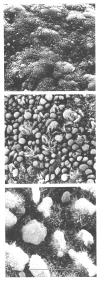Manipulation of the follicular phase: Uterodomes and pregnancy - is there a correlation?
- PMID: 11495634
- PMCID: PMC37312
- DOI: 10.1186/1471-2393-1-2
Manipulation of the follicular phase: Uterodomes and pregnancy - is there a correlation?
Abstract
BACKGROUND: Manipulation of the follicular phase uterine epithelium in women undergoing infertility treatment, has not generally shown differing morphological effects on uterine epithelial characteristics using Scanning Electron Microscopy (SEM) and resultant pregnancy rates have remained suboptimal utilising these manipulations. The present study observed manipulation of the proliferative epithelium, with either 7 or 14 days of sequential oestrogen (E) therapy followed by progesterone (P) and assessed the appearance of pinopods (now called uterodomes) for their usefulness as potential implantation markers in seven women who subsequently became pregnant. Three endometrial biopsies per patient were taken during consecutive cycles: day 19 of a natural cycle - (group 1), days 11/12 of a second cycle after 7 days E then P - (group 2), and days 19/22 of a third cycle after 14 days E then P - (group 3). Embryo transfer (ET) was performed in a subsequent long treatment cycle (as per Group 3). RESULTS: Seven pregnancies resulted in seven viable births including one twins and one miscarriage. Analysis of the individual regimes showed 5 days of P treatment to have a higher correlation for uterodomes in all 3 cycles observed individually. It was also observed that all 7 women demonstrated the appearance of uterodomes in at least one of their cycles. CONCLUSIONS: We conclude that manipulation of the follicular phase by shortening the period of E exposure to 7 days, does not compromise uterine epithelial morphology and we add weight to the conclusion that uterodomes indicate a receptive endometrium for implantation.
Figures



References
-
- Rogers P, Murphy C, Cameron I, Leeton J, Hosie M, Beaton L, Macpherson A. Uterine receptivity in women receiving steroid replacement therapy for premature ovarian failure: ultrastructural and endocrinological parameters. Human Reproduction. 1989;4:349–54. - PubMed
-
- Martel D, Monier MN, Roche D, Psychoyos A. Hormonal dependence of pinopode formation at the uterine luminal surface. Human Reproduction, 1991;6:597–603. - PubMed
-
- Psychoyos A, Nikas G. Uterine pinopods as markers of uterine receptivity. Ass Reprod Rev. 1994;4:26–32.
-
- Kolb BA, Paulson RJ. The luteal phase of cycles utilizing controlled ovarian hyperstimulation and the possible impact of this hyperstimulation on embryo implantation. American Journal of Obstetrics & Gynecology, 1997;176:1262–7. - PubMed
LinkOut - more resources
Full Text Sources

